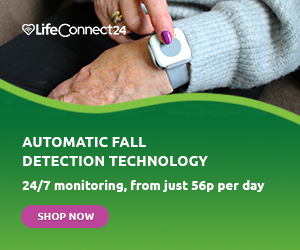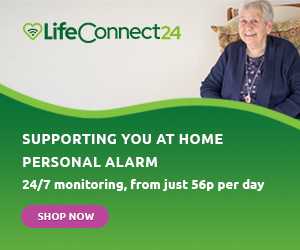Getting up and down the stairs can become quite a challenge as we get older. Lots of us aren’t quite as fit or steady on our feet as we used to be. Common medical conditions such as asthma, arthritis and osteoporosis can make the staircase even more difficult for some older people. This can lead to a fall, which can have fatal consequences.
Sadly, falls are the most common cause of injury-related deaths in people aged 75 and over. In fact, according to The Royal Society for the Prevention of Accidents (ROSPA):
In 2009 in England and Wales alone, people aged 65 or over accounted for 7,475 deaths as a result of an accident, of which 49% were due to a fall.”
The ROSPA also explain that the largest proportion of accidents are falls from stairs and steps, with 60% of deaths resulting from accidents on stairs. Falls commonly result in arm, leg and shoulder injuries, with 25% of falls causing injury to more than one part of the body.
You may have seen our top tips for older people to follow when it comes to staying safe at home. Today’s article focuses on what you can do to try and prevent falls and accidents on the stairs in your home.
Take Your Time
Our first tip for staircase safety would be to take your time. If you often struggle with balance or feeling out of breath, you definitely should not be rushing to get up the stairs. The same is true if you have weaker bones or muscles due to a medical condition.
Take a deep breath before you start walking up the staircase and always use the banister. You should keep hold of the banister until you’ve reached the top or the bottom. If you only have a banister one side of your staircase, consider installing one on the other side too.
The same advice goes double for coming back down the stairs. In fact, you should take even more care when going down your staircase. After all, if you lose your balance or trip, you’re more likely to go tumbling down the stairs.
Ask for Help
Another simple staircase safety tip is to ask for help up and down the stairs. If you live with a partner, family member or friend you can always ask them to give you a hand up the staircase. People will be more than happy to protect you by giving you a helping hand.
If your loved ones are visiting and you need to get something from upstairs at any point, ask one of them to go for you. This will save you the task of doing so later on. We should always make the most of having loved ones around us.
Never be afraid of asking for help. Your loved ones will want to make sure that you are safe.
A Lift for your Staircase
An alternative to walking up and down the staircase is a stairlift. This mechanical, motorised device allows you to take a comfortable seat as it carries you up and down the stairs. There are many different models available, with different designs available for different shaped staircases.
The stairlift will give you a much-needed rest as it carries you up the stairs. It will also remove the risk of staircase trips and falls, giving you and your family peace of mind. Although a stairlift is a big investment, there is financial help available. You might be eligible for a Disabled Facilities Grant. For more information on financial support for stairlifts, see Age UK’s guide. We would advise that you do thorough research before purchasing a stairlift, to make sure you’re choosing the best option for your home and your needs.
Install a Downstairs Toilet
If the idea of a stairlift doesn’t appeal, then it could be a nice idea to install a downstairs toilet. On average, we visit the bathroom around seven times per day. What’s more, older people naturally need to use the toilet more than younger people. If your only bathroom is upstairs, this adds up to lots of trips up and down the stairs.
Having a toilet downstairs removes this need to use the staircase, which in turn decreases the chances of an accident. Of course, having a toilet downstairs also means you don’t have as far to travel to reach it. This can also help to prevent falls, as it means you won’t need to rush.
Installing a downstairs toilet may also increase the value of your home should you ever decide to move.
Consider a Bungalow
If you’re really struggling with your staircase and the ideas we’ve discussed so far aren’t an option, moving to a bungalow might be the best option for you. A bungalow removes the obstacle of a staircase, with every room on the same level.
Lots of older people choose to downsize from a bigger house to a bungalow, as it just makes life much easier. In a bungalow, you’re always close to the room that you need to be in next, without having to walk up and down a staircase.
The one-floor blueprint generally allows for more spacious rooms and more space outside for your garden. Of course, one level also makes a bungalow easier to clean. There is no need to carry a hoover or other bulky equipment up and down the stairs.
Of course, a bungalow is also better for fire safety because any window can be used as a fire escape.
Staying Safe at Home
The tips we’ve shared in this article are a great way to reduce your risk of staircase falls. However, accidents will still happen from time to time, so it’s always best to be prepared. Our personal alarm service is a great way of ensuring that you can always get help if you have a fall. In the event of an accident, simply press the red button on your Pendant, which can be worn comfortably around the wrist or neck.
Our 24-hour Response Team will respond immediately over the loudspeaker in the alarm base unit. They will assess your situation and arrange help by calling your emergency contacts and, if needed, the emergency services.
Here at LifeConnect24, our aim is to help you feel safe and secure at home and on the go. In addition to our standard Lifeline Alarms, we also offer a fall detector plan. This automatically raises a call for help if it sense that you have had a fall. We also provide digital alarms, which provide 24/7 reassurance without requiring a phoneline.
For more information on purchasing one of our life-saving personal alarms, please speak to one of our friendly advisors on 0800 030 8999. Alternatively, complete our contact us form and we will get back to you as soon as possible.
Read our top tips for staying safe at home
Editor’s Note: This article was updated on 13th March 2024.



Leave A Comment